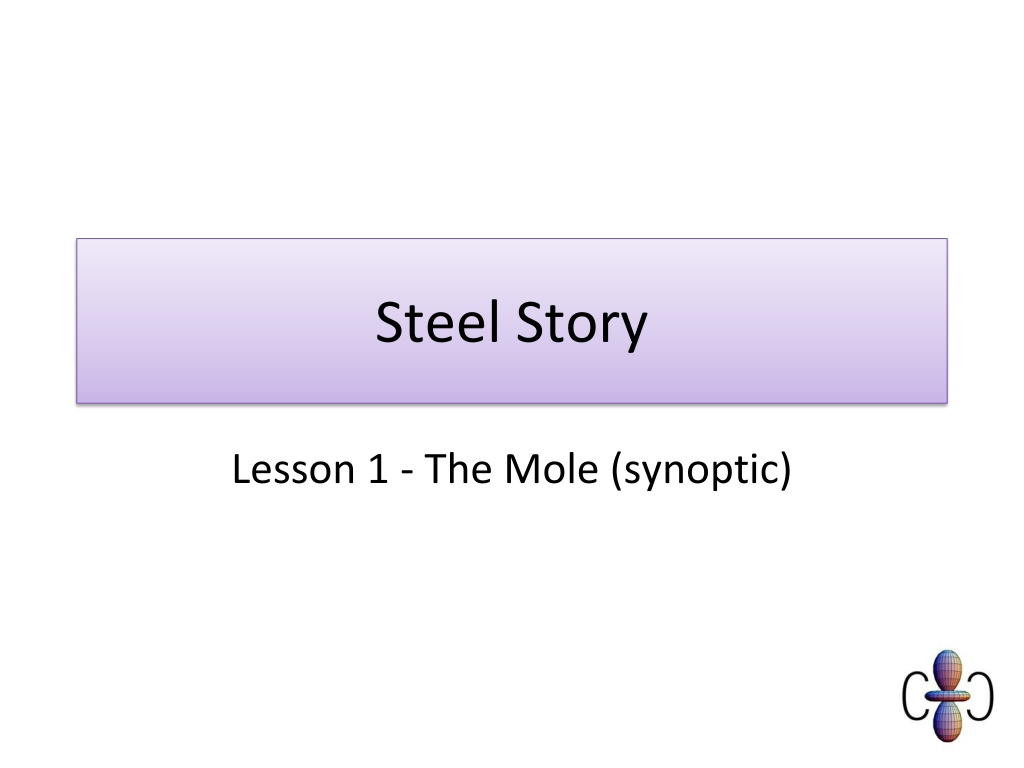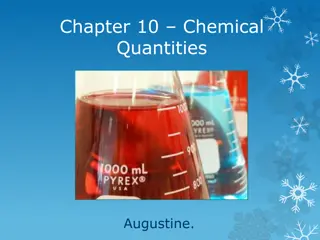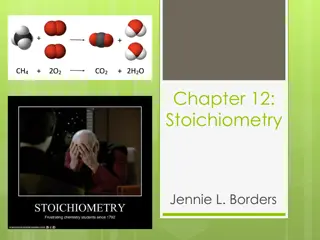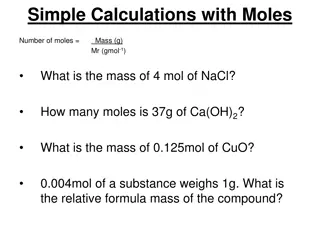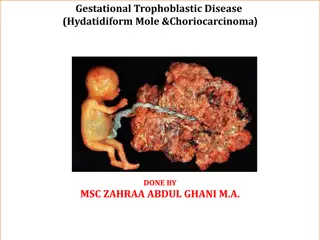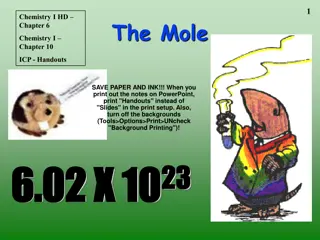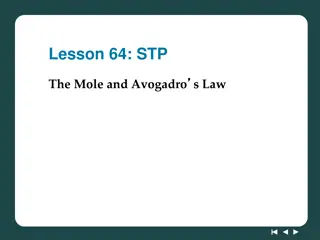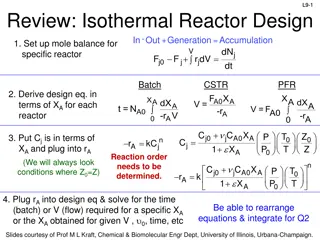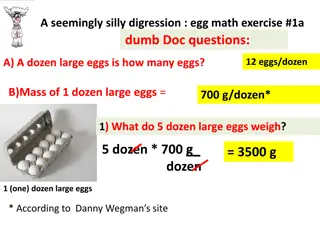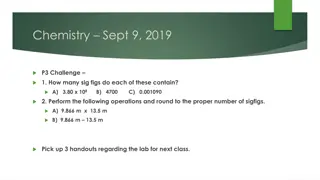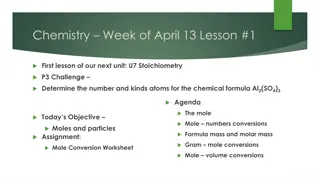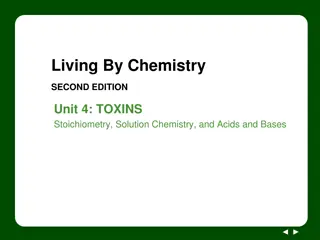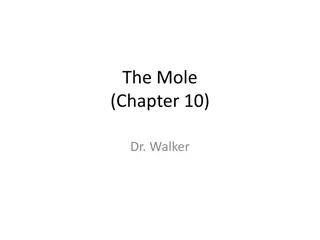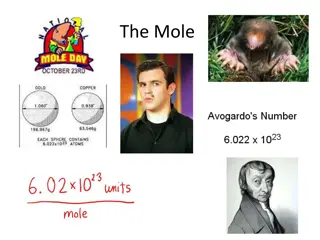Understanding the Mole Concept in Chemistry
Explore the fundamentals of the mole concept in chemistry, including calculations involving molecular formulas, reagent masses, percentage yields, gas volumes, concentrations, and balanced chemical equations. Learn about the definition of a mole, calculating the number of moles, and converting mass to moles using examples and practice scenarios.
Download Presentation

Please find below an Image/Link to download the presentation.
The content on the website is provided AS IS for your information and personal use only. It may not be sold, licensed, or shared on other websites without obtaining consent from the author. Download presentation by click this link. If you encounter any issues during the download, it is possible that the publisher has removed the file from their server.
E N D
Presentation Transcript
Steel Story Lesson 1 - The Mole (synoptic)
Specification statements Use the concept of amount of substance to perform calculations involving; Molecular formulae, Masses of reagents, Percentage yields, Volumes of gases, Volumes of solutions of known concentrations, Balanced chemical equations
Objectives All Recall moles, molar mass and calculating the number of moles. Most Perform calculations involving the amount of substance. Some Write balanced chemical equations and use them to calculate reacting masses and moles.
Starter using whiteboards 1 mole of 12C contains exactly 12 grams of carbon atoms. Which of the statement(s) below is/are correct? 1. 2. 3. 4. 1 mole of oxygen has a mass of exactly 8 grams 1 mole of sodium has a mass of exactly 23 grams 1 mole of chlorine molecules have a mass of exactly 71 grams 1 mole of water molecules have a mass of exactly 10 grams How would you correct the incorrect statements?
The Mole 1 mole is the amount of substance which contains as many particles as there are atoms in exactly 12 grams of 12C. This value is 6.022 x 1023particles. For an element it is the Arin grams For example 1 mole of hydrogen atoms has a mass of exactly 1 gram.
Calculating number of moles Number of moles (mol) = mass (g) molar mass (gmol-1) This equation can be rearranged to calculate mass or molar mass as well as number of moles. Mass (g) No. of moles (mol) Mr (gmol- 1)
Worked Example How many moles of Ca are there in 120g of Ca? Ar Ca = 40, therefore Mr Ca = 40 gmol-1 number of moles = 120 40 = 3.0 mol
AfL using whiteboards Calculate the amount in moles in the following; 1. 32.1 grams of sulfur atoms 2. 50.0 grams of CaCO3 3. 6.35 grams of copper atoms 4. 400 grams of NaOH 5. 69g of Pb 6. 5.30g of Na2CO3
Calculating masses Worked example What mass of NaCl contains 10 moles of NaCl particles? Mr NaCl = 23 + 35.5 = 58.5 therefore Mr of NaCl = 58.5 gmol-1 From the equation on the previous slide ; Mass = moles x Mr Mass = 10 mol x 58.5 gmol-1 = 585 grams
AfL using whiteboards Calculate the mass of 1. 0.013 moles of Cl2 2. 2.00 moles of SO3 3. 0.25 moles S8 4. 0.15 moles of MgSO4.7H2O
Definitions Write your own definitions of ; The mole Molar mass of an element Molar mass of a compound Compare to statements from mark schemes Learn these statements!
Definitions The molar mass of an element is the mass of 6.023 x 1023 atoms of the element and is equal to the relative atomic mass expressed in grams. The molar mass of a compound is the mass of 6.023 x 1023 molecules of the compound and is equal to the relative molecular mass expressed in grams.
Calculating reacting masses Worked example copy down the question A farmer requires 33kg of ammonium sulfate fertiliser. How much ammonia is needed to make this quantity of fertiliser?
STEP 1 write a balanced equation 2NH3 + H2SO4 (NH4)2SO4 STEP 2 calculate moles of known mass Moles of (NH4)2SO4 = mass / Mr = 33kg / 132 = 0.25 moles STEP 3 use the equation to determine the ratio 2 moles of NH3 reacts to form 1 mole of (NH4)2SO4 so moles of NH3 needed = 0.25 x 2 = 0.5 moles STEP 4 calculate mass of unknown Mass = number of moles x Mr = 0.5 x 17 = 8.5kg
Group work In your groups a) Write a balanced equation for each reaction b) Calculate the mass required by the question (reactant or product)
Practice questions 1. The mass of calcium carbonate that would need to be heated to produce 500 tonnes of calcium oxide. 2. The amount of glucose that would be needed to produce 11.5g of ethanol by fermentation. 3. The mass of titanium produced and the mass of sodium necessary for the reduction of 4.75 tonnes of titanium (IV)chloride TiCl4
Answers 1. CaCO3 CaO + CO2 molar mass of CaCO3 = 100 gmol-1 molar mass of CaO = 56 gmol-1 Mass of CaCO3required = 890 tonnes 2. C6H12O6 2C2H5OH 2CO2 Mass of glucose = 22.5g 3. TiCl4 +4Na Ti + 4NaCl Mass of titanium = 1.20 tonnes Mass of sodium = 2.30 tonnes
AfL using whiteboards What mass of ammonium nitrate fertiliser can be made from 18.9 tonnes of nitric acid? Be prepared to explain each step clearly!
AfL - answer STEP 1 NH3 + HNO3 NH4NO3 STEP 2 Moles of nitric acid = 18.9 STEP 3 From the equation the reacting quantities are 1:1 so 0.3 moles of nitric acid will produce 0.3 moles of ammonium nitrate. STEP 4 Mass of ammonium nitrate = 0.3 x 80 = 24 tonnes 63 = 0.3 moles
Plenary - Exam question Barium metal can be extracted from barium oxide, BaO, by reduction with aluminium. 6BaO + 2Al 3Ba + Ba3Al2O6 Calculate the mass of barium metal that could be produced from reduction of 500 g of barium oxide using this method. answer = ............................... g [Total 4 marks]
Answer with indicative marks Mr of BaO = 137 + 16 = 153 (1) moles of BaO = 500/153 or 3.268 mol (1) moles of Ba = 3.268/2 or 1.634 mol (1) mass of Ba formed = 1.634 x 137 = 224 g (accept 223.85g) (1) if 6 mol of BaO forms 3 mol of Ba, award 3rd mark Alternative method mass of 6BaO=918 g (1) mass of 3Ba = 411 g (1) 1g BaO forms 411/918 g Ba = 0.4477 (1) 500 g BaO forms 223.85g (1) [4]
Exam question Antimony is found naturally in a number of minerals including stibnite. Stibnite typically contains 5% of Sb2S3. Antimony can be obtained by reducing Sb2S3 with scrap iron. Sb2S3+ 3Fe 2Sb + 3FeS (i) How many moles of Sb2S3 are in 500 kg of a typical sample of stibnite containing 5% by mass of Sb2S3? molar mass of Sb2S3 = 340 g mol 1; relative atomic mass of Sb = 122 (ii) Calculate the mass of antimony that could be obtained by processing 500 kg of stibnite. mol [2] mass = kg [2] [Total 4 marks]
Answer with indicative marks (i) Mass of Sb2S3 in stibnite = 5% of 500 kg = 25.0 kg Moles of Sb2S3= 73.5/ 73.529 /73.53/ 74 mol (calculator value: 73.52941176) If 5% is not used, 1471 mol; ecf for 2nd mark (calculator value: 1470.588235) If 5% is used 2nd, 73.6 mol: OK for both marks 2 (ii) moles of Sb = 2 x 73.5 mol mass of Sb = 2 x 73.5 x 0.122 kg = 17.9 kg If the 2 isn t used, answer = 73.5 x 0.122kg = 8.95kg ecf answer from (i) x 2 or ecf answer above x 2 OR % Sb = 244/340 = 71.7% mass Sb = 25.0 x 71.7/100 = 17.9 kg (ecf as above) 2 [4]
